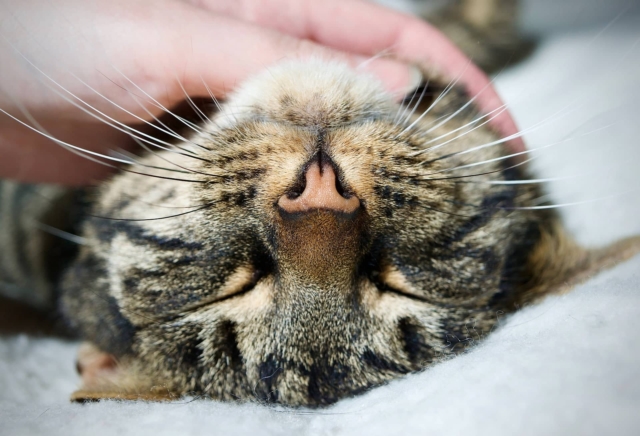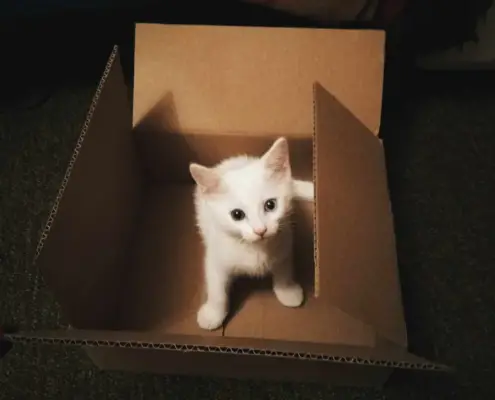
Cats are fascinating creatures with unique behaviors that can both captivate and confuse their owners. To truly understand what makes cats excited, it is essential to delve into their instinctual instincts and natural behaviors. Cats are known predators, and their excitement is often triggered by stimuli that mimic hunting and prey. By understanding these triggers, cat owners can provide stimulating environments and activities to keep their feline companions engaged and happy.
One common trigger that excites cats is movement. Cats have exceptional vision and are highly attuned to even the slightest movement. This explains their fascination with toys that move, such as laser pointers or feather wands. These toys awaken their hunting instincts, allowing them to chase, pounce, and capture their “prey.” The element of surprise and unpredictability in these toys further enhances their excitement. By providing interactive toys that encourage physical activity, owners can keep their cats engaged and mentally stimulated.
Another key trigger for cat excitement is sound. Cats have incredibly sensitive hearing, and certain sounds can instantly grab their attention and spark their curiosity. This is why toys with bells, crinkly materials, or squeakers are often a hit with cats. The irresistible allure of these sounds ignites their hunting instincts and keeps them engaged for hours on end. Additionally, playing audio or video recordings of birds chirping or mice scurrying can provide a simulated hunting experience, keeping your cat entertained and excited.
Toys and activities to keep cats engaged
Cats are natural-born hunters, and providing them with appropriate toys and activities can help satisfy their instinctual needs and keep them engaged. Interactive toys, such as puzzle feeders or treat-dispensing toys, are excellent options to mentally stimulate and challenge your cat. These toys require problem-solving skills and provide a rewarding experience when they successfully obtain their treats. By engaging their minds, these toys not only keep cats excited but also prevent boredom and destructive behaviors.
In addition to interactive toys, there are various other playtime activities that can keep cats engaged. One popular choice is the use of wand toys. These toys consist of a long stick with a dangling object, such as feathers or strings, at the end. By swishing the wand and mimicking the movements of prey, owners can engage their cat’s natural hunting instincts. This interactive playtime not only provides exercise but also strengthens the bond between the owner and the cat.
Furthermore, incorporating hide-and-seek games can provide mental stimulation and excitement for cats. Hide treats or toys in different areas of the house and encourage your cat to find them. This activity taps into their natural prey drive and stimulates their problem-solving skills as they search for hidden treasures. Additionally, providing scratching posts and climbing towers allows cats to engage in their instinctual behaviors while keeping them physically active and mentally stimulated.
Creating a stimulating environment for cats
Creating a stimulating environment is crucial for keeping cats excited and engaged. Cats are curious creatures and thrive in environments that provide opportunities for exploration and sensory stimulation. One way to achieve this is by establishing vertical spaces. Cats love to climb and perch in high places, as it allows them to observe their surroundings from a safe vantage point. Installing cat trees, shelves, or wall-mounted perches can provide vertical spaces that satisfy their natural instincts and keep them entertained.
Another important aspect of a stimulating environment is providing access to windows. Cats are intrigued by the outside world and enjoy watching birds, squirrels, and other wildlife. Positioning cat trees or shelves near windows allows cats to engage in “window-watching,” which not only provides mental stimulation but also brings them closer to their natural hunting instincts. Additionally, placing bird feeders or birdbaths in the yard can attract birds, providing an extra source of excitement for your feline friend.
Enriching the indoor environment with a variety of textures, scents, and sounds can also keep cats excited. Introduce different types of surfaces for them to explore, such as scratching posts, carpeted areas, and soft bedding. Providing cat-friendly herbs, such as catnip or silver vine, can also elicit excitement and playfulness. Additionally, playing calming music or nature sounds can create a soothing ambiance, reducing stress and promoting relaxation, which ultimately enhances their overall engagement and happiness.
Interactive playtime with cats
Interactive playtime is a crucial component of keeping cats excited and engaged. Cats are social animals and enjoy the companionship and interaction with their owners. Regular play sessions not only provide physical exercise but also strengthen the bond between cats and their human companions. Engaging in interactive play allows owners to tap into their cat’s natural instincts and provide the necessary mental and physical stimulation.
When engaging in interactive play with your cat, it is important to use toys that mimic prey and encourage natural hunting behaviors. Wand toys, as mentioned earlier, are excellent options for this purpose. Move the wand in a way that mimics the movements of prey, such as darting, hiding, or jumping. This will trigger your cat’s instinctual responses and keep them actively engaged. Remember to vary the speed and direction of the toy to keep the play session exciting and unpredictable.
Furthermore, it is essential to allow your cat to “win” during play sessions. Cats are motivated by the satisfaction of capturing their “prey.” Let your cat successfully catch and “kill” the toy, as this provides a sense of accomplishment and fulfillment. Reward their successful hunting endeavors with praise or treats, further reinforcing the positive association with playtime and excitement.
Training and mental stimulation for cats
Training is not only for dogs; cats can also benefit from mental stimulation and learning new behaviors. Training sessions provide mental exercise, help build a stronger bond between cats and their owners, and keep them engaged. The key to training cats successfully is using positive reinforcement techniques such as treats, praise, or play as rewards.
Start with simple commands, such as “sit” or “come,” and gradually increase the difficulty level as your cat becomes more proficient. Use clicker training or a consistent verbal cue to signal the desired behavior, followed by an immediate reward. Keep training sessions short and fun, as cats have shorter attention spans compared to dogs. Always end training sessions on a positive note, even if your cat does not fully grasp the new behavior. Patience and consistency are essential for successful training and maintaining your cat’s excitement.
In addition to basic obedience training, you can teach your cat fun tricks or engage in interactive games that stimulate their problem-solving skills. For example, teach your cat to “high-five” or retrieve a toy on command. This not only keeps them mentally stimulated but also provides a source of entertainment for both you and your cat. Remember to always use positive reinforcement and reward your cat’s efforts, as this encourages them to continue learning and staying engaged.
Tips for maintaining a cat’s excitement
Maintaining a cat’s excitement requires consistent effort and a few key considerations. Here are some tips to help you keep your cat engaged and excited:
- Rotate toys: Cats can quickly lose interest in toys that they see every day. Rotate their toys regularly to provide novelty and keep them engaged.
- Use treat-dispensing toys: These toys not only provide entertainment but also provide mental stimulation as your cat figures out how to extract the treats.
- Schedule regular playtime: Set aside dedicated play sessions with your cat each day. This ensures they receive the necessary exercise and mental stimulation.
- Incorporate variety: Introduce a variety of toys, textures, and activities to keep your cat’s environment stimulating and exciting.
- Monitor their preferences: Pay attention to the types of toys and activities that your cat enjoys the most. This allows you to tailor their playtime and environment to their specific preferences.
By incorporating these tips into your cat’s routine, you can maintain their excitement and ensure they lead a fulfilled and engaging life.
The importance of regular exercise for cats
Regular exercise is essential for a cat’s overall health and well-being. Exercise not only helps prevent obesity and weight-related health issues but also provides mental stimulation and outlet for their natural behaviors. Cats are built to be agile and active, and without regular exercise, they can become bored, stressed, and exhibit destructive behaviors.
Interactive play sessions, as mentioned earlier, are an excellent way to provide cats with the exercise they need. Engaging your cat in active play for at least 15-20 minutes each day can help burn off excess energy and keep them physically fit. This can be done using interactive toys, wand toys, or even a simple game of fetch with a small toy or crumpled piece of paper.
Additionally, providing opportunities for cats to engage in independent play is crucial. Interactive toys such as puzzle feeders or balls with treats inside can keep cats entertained and mentally stimulated even when their owners are not available for play sessions. These toys require cats to bat, roll, or manipulate the toy to access the treats, providing both physical and mental exercise.
Furthermore, creating an environment that encourages physical activity is vital. Install cat trees, scratching posts, or climbing shelves to promote climbing, scratching, and jumping. These activities not only provide exercise but also help maintain healthy claws and muscles. Providing vertical spaces and hiding spots also encourages cats to explore and engage in natural behaviors, further enhancing their exercise routine.
Catnip and other natural stimulants for cats
Catnip is a well-known natural stimulant for cats that can induce excitement and playfulness. Catnip contains a compound called nepetalactone, which triggers a response in cats’ brains, leading to a range of behaviors, including rolling, rubbing, and increased energy. Not all cats are affected by catnip, as sensitivity is genetically determined, but for those that are, it can provide an excellent source of stimulation.
To introduce catnip to your cat, you can use catnip-infused toys or sprinkle dried catnip on scratching posts, toys, or bedding. Observe your cat’s reaction to catnip, as some cats may become hyperactive, while others may become more relaxed. It is essential to use catnip in moderation, as prolonged exposure can diminish the effects. Allow your cat to enjoy the catnip for 10-15 minutes, then remove it to prevent overstimulation.
Aside from catnip, there are other natural stimulants that can excite and engage cats. Silver vine, a plant native to Asia, contains actinidine, a compound that has a similar effect on cats as catnip. Valerian root is another herb that can stimulate cats and induce playfulness. However, it is important to note that some cats may have adverse reactions to these substances, so it is best to introduce them gradually and observe your cat’s response.
Enhancing your cat’s happiness and engagement
Understanding what makes cats excited is the first step in providing them with a fulfilling and engaging life. By tapping into their natural instincts and providing appropriate toys, activities, and environments, cat owners can keep their feline companions excited and mentally stimulated. Regular exercise, interactive playtime, and training sessions are crucial for maintaining a cat’s excitement and strengthening the bond between cats and their owners.
Furthermore, natural stimulants such as catnip, silver vine, and valerian root can provide additional sources of excitement and playfulness for cats. It is essential to monitor your cat’s preferences and reactions to these substances and use them in moderation.
By incorporating these strategies and tips into your cat’s daily routine, you can ensure they lead a happy, engaged, and fulfilled life. Remember, a stimulated cat is a healthy cat, both physically and mentally. So go ahead, unleash the secrets of what makes your cat excited, and watch them thrive in their environment.
If you enjoyed my article, I would appreciate you sharing it with your network.

Sima Ndlebe
Sima writes for CatBuzz. He is interested in Cats, Health and Fitness, and Entrepreneurship.
Published: 6 December 2023



